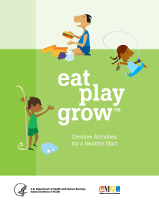EatPlayGrow™ Curriculum Overview with We Can! Messages
| CMOM's EatPlayGrow™ Curriculum | We Can! Messages |
|---|---|
| 1. My Five Senses: Families use their five senses to understand how to listen to their body’s nutrition and physical activity needs. |
Importance of food choices Build a food vocabulary and knowledge base |
| 2. GO, SLOW, WHOA: Families learn the three We Can! food categories and how to recognize foods that are better choices for a healthy body. | GO foods should be eaten often; SLOW foods should be eaten sometimes; and WHOA foods should be eaten sparingly Limit the availability and accessibility of high-fat, high-calorie/low nutrient foods in the home Increase availability and accessibility of healthy foods in the home Balance energy in and energy out Limit the availability and accessibility of sugar- sweetened beverages |
| 3. Fabulous Fruits: Families learn the importance of eating a variety of fruit every day as they learn to categorize, count, and sort fruit choices. | Eat a variety of fruit daily Increase availability and accessibility of healthy foods in the home Limit the availability and accessibility of high-fat, high-calorie/low nutrient foods |
| 4. Move To The Beat: Families learn the importance of physical activity and are introduced to heart health through music, rhythm, and physical activity. | Engage in 60 min. moderate activity on most, preferably all, days of the week Reduce sedentary activity Limit screen time to less than 2 hours daily |
| 5. Energy Balance: To attain a healthy weight, families learn energy in (foods eaten) must balance with energy out (physical activity). | Engage in 60 min. moderate activity on most, preferably all, days of the week Reduce sedentary activity Limit screen time to less than 2 hours daily Decrease intake of WHOA and SLOW foods Increase intake of GO foods |
| 6. I Love My veggies!: Families learn the importance of eating vegetables every day as they explore color, textures, and patterns, and learn new vocabulary. | Eat a variety of vegetables daily Increase availability and accessibility of healthy foods in the home Limit the availability and accessibility of high-fat, high-calorie/low nutrient foods |
| 7. Perfect Portion: Families learn the important connection between portion control and healthy meals. | Limit intake of high-fat and energy-dense foods that are low in nutrients Control portion sizes Sufficient fruit and vegetable intake per day Drink water and fat-free or low-fat milk instead of sugar-sweetened beverages |
| 8. Dem Bones: Families are introduced to the skeletal system and the importance of calcium to build strong bones. | Drink fat-free or low-fat milk instead of sugar- sweetened beverages Eat a variety of vegetables daily Engage in 60 min. moderate activity on most, preferably all, days of the week Reduce sedentary activity Limit screen time to less than 2 hours daily |
| 9. Healthy Beverages Families discover the benefits of drinking fat-free or low-fat milk and water instead of sweetened beverages. | Water and fat-free or low-fat milk instead of sugar- sweetened beverages Limit the availability and accessibility of sugar- sweetened beverages |
| 10. Smart Sleep! Families learn that developing a healthy sleep routine is as important as proper nutrition and physical activity. | Not an official We Can! message, but considered by the NIH to be an important health topic for families |
| 11. Family Meal A chef-led class provides strategies for creating an easy, well-balanced, affordable meal, and a positive meal time environment. | Limit intake of high-fat and high-calorie foods that are low in nutrients Limit the availability and accessibility of sugar- sweetened beverages Control portion sizes Increase availability and accessibility of healthy foods in the home Limit the availability and accessibility of high-fat, high-calorie/low nutrient foods in the home |
| Back to Table of Contents | Back to Top |
NIH Publication No. 13-7818
April 2013











